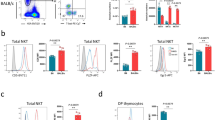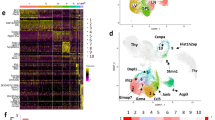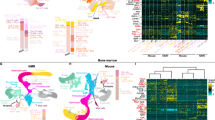Abstract
Previous studies using gene-targeted mutant mice revealed several molecules important for the development or function of invariant natural killer T (iNKT) cells. However, these gene knockout mice represent cases that are rare in humans. Thus, it remains unclear how naturally occurring allelic variants of these genes or others regulate the numerical and functional diversity of iNKT cells in both mice and humans. Studies in humans are mostly limited to iNKT cells in peripheral blood (PB). It is not known if the relative distribution of iNKT cells between PB and other lymphoid organs is correlated or under common genetic control. To initially address these questions, we analyzed iNKT cells in the spleen, thymus and PB of 38 inbred mouse strains. Percentages of iNKT cells in these three anatomical sites varied significantly in a strain-dependent manner. The correlation between PB and spleen was moderate, and none was observed between PB and thymus. Similarly, proportions of the CD4-expressing subset of iNKT cells differed significantly among inbred strains. The percentages of CD4-positive iNKT cells displayed a strong correlation between PB and spleen, although it remained poor between PB and thymus. Genome-wide association studies across strains identified only partially overlapping loci associated with variability of iNKT cell frequencies within and between differing anatomical sites.
This is a preview of subscription content, access via your institution
Access options
Subscribe to this journal
Receive 6 digital issues and online access to articles
$119.00 per year
only $19.83 per issue
Buy this article
- Purchase on Springer Link
- Instant access to full article PDF
Prices may be subject to local taxes which are calculated during checkout





Similar content being viewed by others
References
Bendelac A, Savage PB, Teyton L . The biology of NKT cells. Annu Rev Immunol 2007; 25: 297–336.
Coquet JM, Chakravarti S, Kyparissoudis K, McNab FW, Pitt LA, McKenzie BS et al. Diverse cytokine production by NKT cell subsets and identification of an IL-17-producing CD4-NK1.1- NKT cell population. Proc Natl Acad Sci USA 2008; 105: 11287–11292.
Michel ML, Keller AC, Paget C, Fujio M, Trottein F, Savage PB et al. Identification of an IL-17-producing NK1.1(neg) iNKT cell population involved in airway neutrophilia. J Exp Med 2007; 204: 995–1001.
Matsuda JL, Mallevaey T, Scott-Browne J, Gapin L . CD1d-restricted iNKT cells, the ‘Swiss-Army knife’ of the immune system. Curr Opin Immunol 2008; 20: 358–368.
Hegde S, Fox L, Wang X, Gumperz JE . Autoreactive natural killer T cells: promoting immune protection and immune tolerance through varied interactions with myeloid antigen-presenting cells. Immunology 2010; 130: 471–483.
Berzins SP, Smyth MJ, Baxter AG . Presumed guilty: natural killer T cell defects and human disease. Nat Rev Immunol 2011; 11: 131–142.
Wilson SB, Delovitch TL . Janus-like role of regulatory iNKT cells in autoimmune disease and tumour immunity. Nat Rev Immunol 2003; 3: 211–222.
Naumov YN, Bahjat KS, Gausling R, Abraham R, Exley MA, Koezuka Y et al. Activation of CD1d-restricted T cells protects NOD mice from developing diabetes by regulating dendritic cell subsets. Proc Natl Acad Sci USA 2001; 98: 13838–13843.
Hong S, Wilson MT, Serizawa I, Wu L, Singh N, Naidenko OV et al. The natural killer T-cell ligand alpha-galactosylceramide prevents autoimmune diabetes in non-obese diabetic mice. Nat Med 2001; 7: 1052–1056.
Sharif S, Arreaza GA, Zucker P, Mi QS, Sondhi J, Naidenko OV et al. Activation of natural killer T cells by alpha-galactosylceramide treatment prevents the onset and recurrence of autoimmune Type 1 diabetes. Nat Med 2001; 7: 1057–1062.
Wang B, Geng YB, Wang CR . CD1-restricted NK T cells protect nonobese diabetic mice from developing diabetes. J Exp Med 2001; 194: 313–320.
Shi FD, Flodstrom M, Balasa B, Kim SH, Van Gunst K, Strominger JL et al. Germ line deletion of the CD1 locus exacerbates diabetes in the NOD mouse. Proc Natl Acad Sci USA 2001; 98: 6777–6782.
Lehuen A, Lantz O, Beaudoin L, Laloux V, Carnaud C, Bendelac A et al. Overexpression of natural killer T cells protects Valpha14- Jalpha281 transgenic nonobese diabetic mice against diabetes. J Exp Med 1998; 188: 1831–1839.
Hammond KJ, Poulton LD, Palmisano LJ, Silveira PA, Godfrey DI, Baxter AG . alpha/beta-T cell receptor (TCR)+CD4-CD8- (NKT) thymocytes prevent insulin-dependent diabetes mellitus in nonobese diabetic (NOD)/Lt mice by the influence of interleukin (IL)-4 and/or IL-10. J Exp Med 1998; 187: 1047–1056.
Zekavat G, Mozaffari R, Arias VJ, Rostami SY, Badkerhanian A, Tenner AJ et al. A novel CD93 polymorphism in non-obese diabetic (NOD) and NZB/W F1 mice is linked to a CD4+ iNKT cell deficient state. Immunogenetics 2010; 62: 397–407.
Ueno A, Wang J, Cheng L, Im JS, Shi Y, Porcelli SA et al. Enhanced early expansion and maturation of semi-invariant NK T cells inhibited autoimmune pathogenesis in congenic nonobese diabetic mice. J Immunol 2008; 181: 6789–6796.
Fletcher JM, Jordan MA, Snelgrove SL, Slattery RM, Dufour FD, Kyparissoudis K et al. Congenic analysis of the NKT cell control gene Nkt2 implicates the peroxisomal protein Pxmp4. J Immunol 2008; 181: 3400–3412.
Chen YG, Driver JP, Silveira PA, Serreze DV . Subcongenic analysis of genetic basis for impaired development of invariant NKT cells in NOD mice. Immunogenetics 2007; 59: 705–712.
Matsuki N, Stanic AK, Embers ME, Van Kaer L, Morel L, Joyce S . Genetic dissection of V alpha 14J alpha 18 natural T cell number and function in autoimmune-prone mice. J Immunol 2003; 170: 5429–5437.
Kukreja A, Cost G, Marker J, Zhang C, Sun Z, Lin-Su K et al. Multiple immuno-regulatory defects in type-1 diabetes. J Clin Invest 2002; 109: 131–140.
Wilson SB, Kent SC, Patton KT, Orban T, Jackson RA, Exley M et al. Extreme Th1 bias of invariant Valpha24JalphaQ T cells in type 1 diabetes. Nature 1998; 391: 177–181.
Roman-Gonzalez A, Moreno ME, Alfaro JM, Uribe F, Latorre-Sierra G, Rugeles MT et al. Frequency and function of circulating invariant NKT cells in autoimmune diabetes mellitus and thyroid diseases in Colombian patients. Hum Immunol 2009; 70: 262–268.
Lee PT, Putnam A, Benlagha K, Teyton L, Gottlieb PA, Bendelac A . Testing the NKT cell hypothesis of human IDDM pathogenesis. J Clin Invest 2002; 110: 793–800.
Montoya CJ, Pollard D, Martinson J, Kumari K, Wasserfall C, Mulder CB et al. Characterization of human invariant natural killer T subsets in health and disease using a novel invariant natural killer T cell-clonotypic monoclonal antibody, 6B11. Immunology 2007; 122: 1–14.
Kis J, Engelmann P, Farkas K, Richman G, Eck S, Lolley J et al. Reduced CD4+ subset and Th1 bias of the human iNKT cells in Type 1 diabetes mellitus. J Leukoc Biol 2007; 81: 654–662.
Nakamura T, Sonoda KH, Faunce DE, Gumperz J, Yamamura T, Miyake S et al. CD4+ NKT cells, but not conventional CD4+ T cells, are required to generate efferent CD8+ T regulatory cells following antigen inoculation in an immune-privileged site. J Immunol 2003; 171: 1266–1271.
Roelofs-Haarhuis K, Wu X, Gleichmann E . Oral tolerance to nickel requires CD4+ invariant NKT cells for the infectious spread of tolerance and the induction of specific regulatory T cells. J Immunol 2004; 173: 1043–1050.
Terabe M, Matsui S, Noben-Trauth N, Chen H, Watson C, Donaldson DD et al. NKT cell-mediated repression of tumor immunosurveillance by IL-13 and the IL-4R-STAT6 pathway. Nat Immunol 2000; 1: 515–520.
Berzins SP, Cochrane AD, Pellicci DG, Smyth MJ, Godfrey DI . Limited correlation between human thymus and blood NKT cell content revealed by an ontogeny study of paired tissue samples. Eur J Immunol 2005; 35: 1399–1407.
Berzins SP, Kyparissoudis K, Pellicci DG, Hammond KJ, Sidobre S, Baxter A et al. Systemic NKT cell deficiency in NOD mice is not detected in peripheral blood: implications for human studies. Immunol Cell Biol 2004; 82: 247–252.
Kent SC, Chen Y, Clemmings SM, Viglietta V, Kenyon NS, Ricordi C et al. Loss of IL-4 secretion from human type 1a diabetic pancreatic draining lymph node NKT cells. J Immunol 2005; 175: 4458–4464.
Chan AC, Serwecinska L, Cochrane A, Harrison LC, Godfrey DI, Berzins SP . Immune characterization of an individual with an exceptionally high natural killer T cell frequency and her immediate family. Clin Exp Immunol 2009; 156: 238–245.
Rymarchyk SL, Lowenstein H, Mayette J, Foster SR, Damby DE, Howe IW et al. Widespread natural variation in murine natural killer T-cell number and function. Immunology 2008; 125: 331–343.
Godfrey DI, Berzins SP . Control points in NKT-cell development. Nat Rev Immunol 2007; 7: 505–518.
Godfrey DI, Stankovic S, Baxter AG . Raising the NKT cell family. Nat Immunol 2010; 11: 197–206.
Chen YG, Chen J, Osborne MA, Chapman HD, Besra GS, Porcelli SA et al. CD38 is required for the peripheral survival of immunotolerogenic CD4+ invariant NK T cells in nonobese diabetic mice. J Immunol 2006; 177: 2939–2947.
Yang IV, Wade CM, Kang HM, Alper S, Rutledge H, Lackford B et al. Identification of novel genes that mediate innate immunity using inbred mice. Genetics 2009; 183: 1535–1544.
Bennett BJ, Farber CR, Orozco L, Kang HM, Ghazalpour A, Siemers N et al. A high-resolution association mapping panel for the dissection of complex traits in mice. Genome Res 2010; 20: 281–290.
Bopp SE, Ramachandran V, Henson K, Luzader A, Lindstrom M, Spooner M et al. Genome wide analysis of inbred mouse lines identifies a locus containing Ppar-gamma as contributing to enhanced malaria survival. PLoS One 2010; 5: e10903.
Zimmer MI, Nguyen HP, Wang B, Xu H, Colmone A, Felio K et al. Polymorphisms in CD1d affect antigen presentation and the activation of CD1d-restricted T cells. Proc Natl Acad Sci USA 2009; 106: 1909–1914.
Fedeli M, Napolitano A, Wong MP, Marcais A, de Lalla C, Colucci F et al. Dicer-dependent microRNA pathway controls invariant NKT cell development. J Immunol 2009; 183: 2506–2512.
Zhou L, Seo KH, He HZ, Pacholczyk R, Meng DM, Li CG et al. Tie2cre-induced inactivation of the miRNA-processing enzyme Dicer disrupts invariant NKT cell development. Proc Natl Acad Sci USA 2009; 106: 10266–10271.
Esteban LM, Tsoutsman T, Jordan MA, Roach D, Poulton LD, Brooks A et al. Genetic control of NKT cell numbers maps to major diabetes and lupus loci. J Immunol 2003; 171: 2873–2878.
Jordan MA, Fletcher JM, Jose R, Chowdhury S, Gerlach N, Allison J et al. Role of SLAM in NKT Cell Development Revealed by Transgenic Complementation in NOD Mice. J Immunol 2011; 186: 3953–3965.
Jordan MA, Fletcher JM, Pellicci D, Baxter AG . Slamf1, the NKT cell control gene Nkt1. J Immunol 2007; 178: 1618–1627.
Griewank K, Borowski C, Rietdijk S, Wang N, Julien A, Wei DG et al. Homotypic interactions mediated by Slamf1 and Slamf6 receptors control NKT cell lineage development. Immunity 2007; 27: 751–762.
Kang HM, Zaitlen NA, Wade CM, Kirby A, Heckerman D, Daly MJ et al. Efficient control of population structure in model organism association mapping. Genetics 2008; 178: 1709–1723.
Yang H, Ding Y, Hutchins LN, Szatkiewicz J, Bell TA, Paigen BJ et al. A customized and versatile high-density genotyping array for the mouse. Nat Methods 2009; 6: 663–666.
Acknowledgements
This work was supported by the National Institutes of Health grants DK46266 and DK51090 (to DVS) and DK077443 (to Y-GC).
Author information
Authors and Affiliations
Corresponding author
Ethics declarations
Competing interests
The authors declare no conflict of interest.
Rights and permissions
About this article
Cite this article
Chen, YG., Tsaih, SW. & Serreze, D. Genetic control of murine invariant natural killer T-cell development dynamically differs dependent on the examined tissue type. Genes Immun 13, 164–174 (2012). https://doi.org/10.1038/gene.2011.68
Received:
Revised:
Accepted:
Published:
Issue Date:
DOI: https://doi.org/10.1038/gene.2011.68
Keywords
This article is cited by
-
Regulation of invariant NKT cell development and function by a 0.14 Mbp locus on chromosome 1: a possible role for Fcgr3
Genes & Immunity (2019)
-
A locus on mouse chromosome 13 inversely regulates CD1d expression and the development of invariant natural killer T-cells
Genes & Immunity (2015)
-
Genetic control of murine invariant natural killer T cells maps to multiple type 1 diabetes regions
Genes & Immunity (2013)



